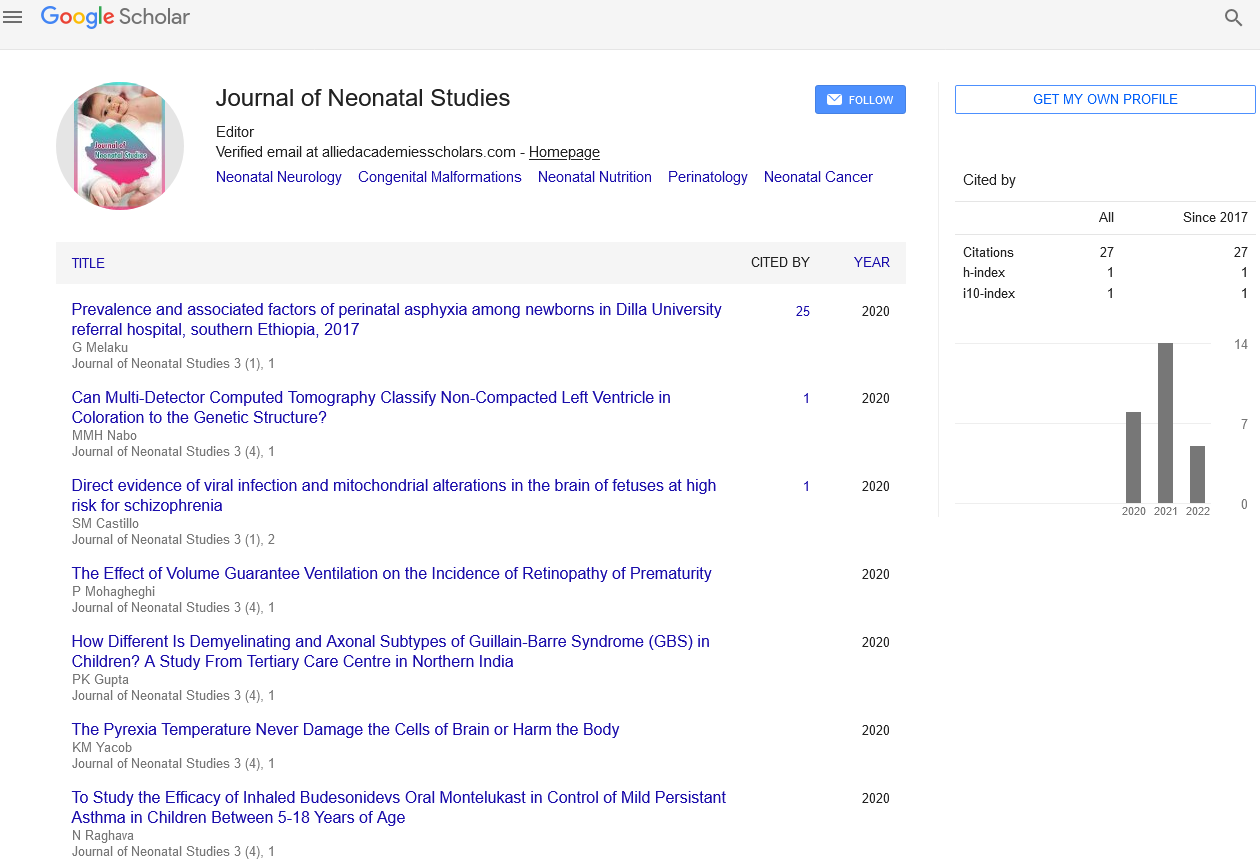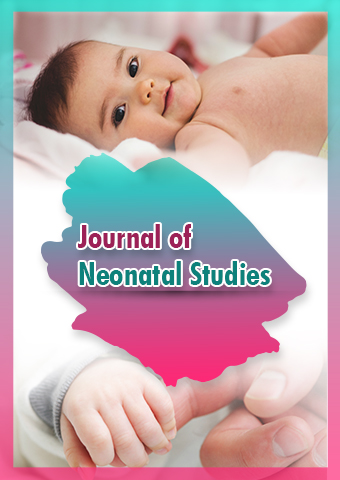Short Article - Journal of Neonatal Studies (2020) Volume 3, Issue 2
Sexual Dimorphism in Brain Content of Microglial Cells in Neonate Mice
Maryam Khajeh-Mobarakeh, Farshad Homayouni Moghadam
Royan Institute for Biotechnology, Iran
Abstract
Brain microglia is known as resident immune cells in the brain. These cells begin to appear in the brain during the embryonic period and are of non-neural origin. Part of the evolution of the brain is related to the function of microglia and their role on neuro-developmental genderrelated structural differences in the brain. Also, there are gender-related differences in the neuro-immunological responses in the brain, for instance, in the female brain there is the phenomenon of microchimerism. To study microglia, primary cells or immortal microglia cells can be used, however, recent findings show that primary microglia are more in line with the reality of the brain. In this study, we assessed the culture specificities of male and female primary microglia extracted from the neonate mice.
Keywords: Microglia, Sex, Brain, Dimorphism, Neonatal, Cell culture
Introduction:
Microglia cells are resident immune cells of brain (1). Recent studies have shown that microglia originate from primitive yolk-sac-derived microglial progenitors (not hematopoietic) (2), and respond to pathological changes in the CNS such as inflammation, ischemia, trauma and neurodegenerative diseases (3). Microglia cells have different morphological states rod like, amoeboid and branched (resting microglia) (4). In recent years, special attention has been projected toward studying the gender dimorphism in microglia function in healthy and diseased states. According to these studies, there are gender differences in many processes of the brain and some part of them were attributed to microglia function (5). According to these studies, the number and morphology of microglia cells and expression of some of the immune-responsive genes depends on the age, gender and even the region of the brain (6). It has also been shown that male rats have a higher microglia than females on the fourth day after birth, and in contrast, females in P30 (post neonatal day 30) and P60 have higher microglia in similar areas than males. These data suggest that in male and female rats there may be many differences in microglia function (6). This theory is proposed that some of these differences may be attributed to the neurodevelopmental functions of the microglia (7). To study microglia, primary microglia cells or immortal microglia cells can be used. However, recent findings show that primary microglia are more similar to brain microglia in terms of their transcriptome similarities. In this study, we investigated the differences in the isolation and culture of microglial cells from male and female P3 mice to better understand their initial characteristics.
Materials and methods
1-Animal
Male and female P3 neonate C57BL6 mice (Male, n = 15, Female, n = 15, age=3 days’ post neonatal (P3)) were used. Animals were kept in the dark cycle of 12-hour lighting and freely accessible to water and food. Care and maintenance of mice were carried out according to the approved regulations for studies using laboratory animals by Royan institute. Gender determination was performed by determining the anogenital distance (AGD) with the male AGD approximately twice as long as that in female mice (8).
2-Brain extraction and isolation of mixed glial cells
The brains of male and female mice were excluded according to the Ethics of laboratory animals, and after washing with PBS-containing 2x penicillin/streptomycin, sliced by surgical blade and then were incubated in trypsin enzyme (0.25%) for 20 minutes, then trypsin enzyme was neutralized and the culture medium containing cells (mixed glia) were passed through the nylon mesh 70-μm to separate the undigested tissues. Then cells were collected by centrifugation and transferred to T75 flasks coated with poly L-Lysine in microglia medium (Dulbecco's Modified Eagle's medium (DMEM, 32500-035) with 10% fetal bovine serum (FBS, 10270) and 1% penicillin/streptomycin (15070)) and incubated in cell culture incubator. All culture media and reagents provided from ThermoFisher Scientific, USA.
3-Microglia Extraction
When cells reached to 90% of confluency, their medium was changed with fresh one and flasks were placed for one hour in the shaking incubator (37 °c and 150 rpm) to mechanically detach microglia from other cells. The supernatant containing microglia cells were transferred into the centrifuge tube and were collected by centrifugation and after counting they were cultivated in 6-well plates. Cell counts were performed using Hemocytometer and every count repeated for 3 times for cells extracted from each animal/flask. To estimate the percent of rodlike, amoeboid and ramified microglia, 10 images were captured from each well of 6-well culture plate and their phenotypes were counted using Image j software.
4- Characterization of Microglia cells using flow cytometry technique
Cells were fixed using 2% paraformaldehyde (PFA) in PBS and after permeabilization (0.7% Tween-20 in PBS) they were stained against CD11b, CD45 and intra-cellular marker CD68 using routine immunostaining methods. Antibodies were anti-CD11b (Abcam, ab133357), anti-CD45 antibody (Abcam, ab40763), and anti-CD68 antibody (Abcam, ab125047). Then, after incubation with appropriate secondary antibody (goat anti-rabbit IgG H&L, FITC, Abcam, ab6717) several washes were performed and then flow cytometry assay was performed.
Results:
Flow cytometry assay
Results of flow cytometry assay confirmed that isolated cells were microglia. According to the results, among the isolated cells, the CD45 marker was expressed in about 20% of cells, CD68 marker was expressed in 60% of the cells and CD11B markers in 90% of the cells which is the specific marker expression profile for microglial cells (Fig. 1).
Cell counts in male and female microglia
Results of cell count showed that (Fig. 2C) the men number of isolated microglia from male neonates were significantly higher than that in female ones (** p <0.01). This cell counts were performed in similar conditions and using similar procedures for both genders and were done before their culture in 6-well plates.
Gender difference in microglia phenotypes
After culture, microglia had taken variety of morphologies, including: Ramified for cells that had several branches around them, rod-like, and amoeboid for cells that have an almost round appearance and no branches. In both male and female mice, the number of rod-like microglia were significantly higher than ramified and amoeboid types (P<0.05) (fig 2B). The mean percentage of ramified cells was higher in male while in female the mean numbers of amoeboid cells were slightly higher, but both of them were not significantly different.
Discussion
In this study, after extracting microglia cells from mixed-glia, their number and morphologies were evaluated and it was observed that they show similar morphological state with dominated rod-like morphology. In previous reports the same morphological configurations were reported [1, 6]. Our findings showed that there is not significant gender difference in morphological states of microglial cells. However, even though it was not significant but the mean percent of amoeboid microglia were higher in female mice, and ramified ones were higher in male mice. In accordance with this finding, Nelson et al. have reported that the amount of phagocytic microglia in female increased compared to male in three days old mice [1].
In the case of cell number of cells our findings showed that the number of primary microglia that isolated from male mixed glia culture was significantly higher than that from female mice. We used in vitro cell culture assays but interestingly in vivo studies already have reported same findings that male neonate P4 mice brain has more microglial cells compared to the female brain [6]. Schwarz et al. in their study by using the optical fractionator method have shown that the number of Iba1 labeled cells were higher in male neonate P4 mice brain sections than females (6).
Our study proved that there is a gender difference in the number of isolated microglia from mixed glia culture and it can be considered as a useful method in for studying gender differences in the function of microglia.
Disclosure Statement
The authors have no conflicts of interest to declare
Flow cytometry results from microglia stained for CD45, CD11b and CD68 markers, 20% of cells expressed CD45 marker, 60% CD68 marker and 91% CD11b marker.
A) Primary microglial cells from male and female P3 mice brain in culture. B) percentage of each type of cultured microglia based on their morphology (Amoeboid, Rod-like and ramified). C) Number of isolated primary microglia cells from male and female mice.
References
- Nelson LH, Warden S, Lenz KM. Sex differences in microglial phagocytosis in the neonatal hippocampus. Brain, behavior, and immunity. 2017;64:11-22.
- Nayak D, Roth TL, McGavern DB. Microglia development and function. Annual review of immunology. 2014;32:367-402.
- Azevedo FA, Carvalho LR, Grinberg LT, Farfel JM, Ferretti RE, Leite RE, et al. Equal numbers of neuronal and nonneuronal cells make the human brain an isometrically scaledâ€Âup primate brain. Journal of Comparative Neurology. 2009;513(5):532-41.
- Wierzba-Bobrowicz T, Gwiazda E, Kosno-Kruszewska E, Lewandowska E, Lechowicz W, Bertrand E, et al. Morphological analysis of active microglia-rod and ramified microglia in human brains affected by some neurological diseases (SSPE, Alzheimer's disease and Wilson's disease). Folia neuropathologica. 2002;40(3):125-32.
- Solomon MB, Herman JP. Sex differences in psychopathology: of gonads, adrenals and mental illness. Physiology & behavior. 2009;97(2):250-8.
- Schwarz JM, Sholar PW, Bilbo SD. Sex differences in microglial colonization of the developing rat brain. Journal of neurochemistry. 2012;120(6):948-63.
- Cowan M, Petri Jr WA. Microglia: immune regulators of neurodevelopment. Frontiers in immunology. 2018;9:2576.
- Hotchkiss AK, Vandenbergh JG. The anogenital distance index of mice (Mus musculus domesticus): an analysis. Contemporary topics in laboratory animal science. 2005;44(4):46-8. Epub 2005/07/30. PubMed PMID: 16050669.

